Tunable Multilevel Data Storage Bioresistive Random Access Memory Device Based on Egg Albumen and Carbon Nanotubes
Abstract
1. Introduction
2. Materials and Methods
2.1. Fabrication of the Flexible Memristor
2.2. Characterizations and Electrical Measurements of the Memristor
3. Results and Discussion
3.1. Device Structure and Material Characterization
3.2. Memristor Performance
3.3. Mechanism of the Memristive Switch
4. Conclusions
Author Contributions
Funding
Conflicts of Interest
References
- Sokolov, A.S.; Abbas, H.; Abbas, Y.; Choi, C. Towards engineering in memristors for emerging memory and neuromorphic computing: A review. J. Semicond. 2021, 42, 013101. [Google Scholar] [CrossRef]
- Lee, T.H.; Hwang, H.G.; Woo, J.U.; Kim, D.H.; Kim, T.W.; Nahm, S. Synaptic Plasticity and Metaplasticity of Biological Synapse Realized in a KNbO3 Memristor for Application to Artificial Synapse. ACS Appl. Mater. Interfaces 2018, 10, 25673–25682. [Google Scholar] [CrossRef] [PubMed]
- Lee, A.R.; Bae, Y.C.; Baek, G.H.; Chung, J.B.; Lee, S.H.; Im, H.S.; Hong, J.P. Multifunctional resistive switching behaviors employing various electroforming steps. J. Mater. Chem. C 2016, 4, 823–830. [Google Scholar] [CrossRef]
- Dang, B.; Wu, Q.; Song, F.; Sun, J.; Yang, M.; Ma, X.; Wang, H.; Hao, Y. A bio-inspired physically transient/biodegradable synapse for security neuromorphic computing based on memristors. Nanoscale 2018, 10, 20089–20095. [Google Scholar] [CrossRef]
- Wu, S.; Ren, L.; Qing, J.; Yu, F.; Yang, K.; Yang, M.; Wang, Y.; Meng, M.; Zhou, W.; Zhou, X.; et al. Bipolar resistance switching in transparent ITO/LaAlO(3)/SrTiO(3) memristors. ACS Appl. Mater. Interfaces 2014, 6, 8575–8579. [Google Scholar] [CrossRef] [PubMed]
- Celano, U.; Nagashima, K.; Koga, H.; Nogi, M.; Zhuge, F.; Meng, G.; He, Y.; De Boeck, J.; Jurczak, M.; Vandervorst, W.; et al. All-nanocellulose nonvolatile resistive memory. NPG Asia Mater. 2016, 8, e310. [Google Scholar] [CrossRef]
- Hung, Y.-C.; Hsu, W.-T.; Lin, T.-Y.; Fruk, L. Photoinduced write-once read-many-times memory device based on DNA biopolymer nanocomposite. Appl. Phys. Lett. 2011, 99, 277. [Google Scholar] [CrossRef]
- Chu, H.-L.; Lai, J.-J.; Wu, L.-Y.; Chang, S.-L.; Liu, C.-M.; Jian, W.-B.; Chen, Y.-C.; Yuan, C.-J.; Wu, T.-S.; Soo, Y.-L.; et al. Exploration and characterization of the memcapacitor and memristor properties of Ni–DNA nanowire devices. NPG Asia Mater. 2017, 9, e430. [Google Scholar] [CrossRef][Green Version]
- Hosseini, N.R.; Lee, J.-S. Biocompatible and Flexible Chitosan-Based Resistive Switching Memory with Magnesium Electrodes. Adv. Funct. Mater. 2015, 25, 5586–5592. [Google Scholar] [CrossRef]
- Raeis-Hosseini, N.; Lee, J.S. Controlling the Resistive Switching Behavior in Starch-Based Flexible Biomemristors. ACS Appl. Mater. Interfaces 2016, 8, 7326–7332. [Google Scholar] [CrossRef]
- Hota, M.K.; Bera, M.K.; Kundu, B.; Kundu, S.C.; Maiti, C.K. A Natural Silk Fibroin Protein-Based Transparent Bio-Memristor. Adv. Funct. Mater. 2012, 22, 4493–4499. [Google Scholar] [CrossRef]
- Wang, L.; Wen, D. Nonvolatile Bio-Memristor Based on Silkworm Hemolymph Proteins. Sci. Rep. 2017, 7, 17418. [Google Scholar] [CrossRef]
- Wang, H.; Meng, F.; Cai, Y.; Zheng, L.; Li, Y.; Liu, Y.; Jiang, Y.; Wang, X.; Chen, X. Sericin for resistance switching device with multilevel nonvolatile memory. Adv. Mater. 2013, 25, 5498–5503. [Google Scholar] [CrossRef] [PubMed]
- Zhou, G.; Yao, Y.; Lu, Z.; Yang, X.; Han, J.; Wang, G.; Rao, X.; Li, P.; Liu, Q.; Song, Q. Hydrogen-peroxide-modified egg albumen for transparent and flexible resistive switching memory. Nanotechnology 2017, 28, 425202. [Google Scholar] [CrossRef] [PubMed]
- Bok, C.H.; Woo, S.J.; Wu, C.; Park, J.H.; Kim, T.W. Flexible bio-memristive devices based on chicken egg albumen:Au@SiO2 core-shell nanoparticle nanocomposites. Sci. Rep. 2017, 7, 12033. [Google Scholar] [CrossRef] [PubMed]
- Chen, Y.-C.; Yu, H.-C.; Huang, C.-Y.; Chung, W.-L.; Wu, S.-L.; Su, Y. Nonvolatile Bio-Memristor Fabricated with Egg Albumen Film. Sci. Rep. 2015, 5, 1–12. [Google Scholar] [CrossRef]
- Qu, B.; Lin, Q.; Wan, T.; Du, H.; Chen, N.; Lin, X.; Chu, D. Transparent and flexible write-once-read-many (WORM) memory device based on egg albumen. J. Phys. D Appl. Phys. 2017, 50, 315105. [Google Scholar] [CrossRef]
- Wang, L.; Wang, J.; Wen, D. Devices with Tunable Resistance Switching Characteristics Based on a Multilayer Structure of Graphene Oxide and Egg Albumen. Nanomaterials 2020, 10, 1491. [Google Scholar] [CrossRef]
- He, X.; Zhang, J.; Wang, W.; Xuan, W.; Wang, X.; Zhang, Q.; Smith, C.G.; Luo, J. Transient Resistive Switching Devices Made from Egg Albumen Dielectrics and Dissolvable Electrodes. ACS Appl. Mater. Interfaces 2016, 8, 10954–10960. [Google Scholar] [CrossRef]
- Wu, G.; Feng, P.; Wan, X.; Zhu, L.; Shi, Y.; Wan, Q. Artificial Synaptic Devices Based on Natural Chicken Albumen Coupled Electric-Double-Layer Transistors. Sci. Rep. 2016, 6, 23578. [Google Scholar] [CrossRef]
- Sung, S.; Park, J.H.; Wu, C.; Kim, T.W. Biosynaptic devices based on chicken egg albumen:graphene quantum dot nanocomposites. Sci. Rep. 2020, 10, 1255. [Google Scholar] [CrossRef] [PubMed]
- Yan, X.; Li, X.; Zhou, Z.; Zhao, J.; Wang, H.; Wang, J.; Zhang, L.; Ren, D.; Zhang, X.; Chen, J.; et al. A Flexible Transparent Organic Artificial Synapse based on Tungsten/Egg Albumen/Indium Tin Oxide/polyethylene Terephthalate Memristor. ACS Appl. Mater. Interfaces 2019, 11, 18654–18661. [Google Scholar] [CrossRef] [PubMed]
- Zhu, J.X.; Zhou, W.L.; Wang, Z.Q.; Xu, H.Y.; Lin, Y.; Liu, W.Z.; Ma, J.G.; Liu, Y.C. Flexible, transferable and conformal egg albumen based resistive switching memory devices. RSC Adv. 2017, 7, 32114–32119. [Google Scholar] [CrossRef]
- Zhou, G.; Ren, Z.; Wang, L.; Sun, B.; Duan, S.; Song, Q. Artificial and wearable albumen protein memristor arrays with integrated memory logic gate functionality. Mater. Horiz. 2019, 6, 1877–1882. [Google Scholar] [CrossRef]
- Chang, J.W.; Wang, C.G.; Huang, C.Y.; Tsai, T.D.; Guo, T.F.; Wen, T.C. Chicken albumen dielectrics in organic field-effect transistors. Adv. Mater. 2011, 23, 4077–4081. [Google Scholar] [CrossRef]
- Jeon, D.-B.; Bak, J.-Y.; Yoon, S.-M. Oxide Thin-Film Transistors Fabricated Using Biodegradable Gate Dielectric Layer of Chicken Albumen. Jpn. J. Appl. Phys. 2013, 52, 128002. [Google Scholar] [CrossRef]
- Chen, J.; Liu, B.; Gao, X.; Xu, D. A review of the interfacial characteristics of polymer nanocomposites containing carbon nanotubes. RSC Adv. 2018, 8, 28048–28085. [Google Scholar] [CrossRef]
- Kanth, S.K.; Sharma, A.; Park, B.C.; Kim, H.S. Multiwalled carbon nanotube field emitter as an electron source for a microcolumn. J. Vac. Sci. Technol. B Nanotechnol. Microelectron. Mater. Process. Meas. Phenom. 2016, 34, 011805. [Google Scholar] [CrossRef]
- Ko, Y.; Kim, J.S.; Vu, C.C.; Kim, J. Ultrasensitive Strain Sensor Based on Pre-Generated Crack Networks Using Ag Nanoparticles/Single-Walled Carbon Nanotube (SWCNT) Hybrid Fillers and a Polyester Woven Elastic Band. Sensors 2021, 21, 2531. [Google Scholar] [CrossRef]
- Say, Y.; Guler, O.; Dikici, B. Carbon nanotube (CNT) reinforced magnesium matrix composites: The effect of CNT ratio on their mechanical properties and corrosion resistance. Mater. Sci. Eng. A 2020, 798, 139616. [Google Scholar] [CrossRef]
- Xu, R.; Wang, W.; Yu, D. A novel multilayer sandwich fabric-based composite material for infrared stealth and super thermal insulation protection. Compos. Struct. 2019, 212, 58–65. [Google Scholar] [CrossRef]
- Yang, H.; Lombardo, L.; Luo, W.; Kim, W.; Züttel, A. Hydrogen storage properties of various carbon supported NaBH4 prepared via metathesis. Int. J. Hydrog. Energy 2018, 43, 7108–7116. [Google Scholar] [CrossRef]
- Liu, G.; Ling, Q.-D.; Teo, E.Y.H.; Zhu, C.-X.; Chan, D.S.-H.; Neoh, K.-G.; Kang, E.-T. Electrical Conductance Tuning and Bistable Switching in Poly(Nvinylcarbazole)-Carbon Nanotube Composite Films. ACS Nano 2009, 3, 1929–1937. [Google Scholar] [CrossRef] [PubMed]
- Ageev, O.A.; Blinov, Y.F.; Il’in, O.I.; Kolomiitsev, A.S.; Konoplev, B.G.; Rubashkina, M.V.; Smirnov, V.A.; Fedotov, A.A. Memristor effect on bundles of vertically aligned carbon nanotubes tested by scanning tunnel microscopy. Tech. Phys. 2013, 58, 1831–1836. [Google Scholar] [CrossRef]
- Liu, G.; Ling, Q.-D.; Kang, E.-T.; Neoh, K.-G.; Liaw, D.-J.; Chang, F.-C.; Zhu, C.-X.; Chan, D.S.-H. Bistable electrical switching and write-once read-many-times memory effect in a donor-acceptor containing polyfluorene derivative and its carbon nanotube composites. J. Appl. Phys. 2007, 102, 024592. [Google Scholar] [CrossRef]
- Kim, K.; Chen, C.L.; Truong, Q.; Shen, A.M.; Chen, Y. A carbon nanotube synapse with dynamic logic and learning. Adv. Mater. 2013, 25, 1693–1698. [Google Scholar] [CrossRef]
- Molinari, F.N.; Barragán, E.; Bilbao, E.; Patrone, L.; Giménez, G.; Medrano, A.V.; Tolley, A.; Monsalve, L.N. An electrospun polymer composite with fullerene-multiwalled carbon nanotube exohedral complexes can act as memory device. Polymer 2020, 194, 122380. [Google Scholar] [CrossRef]
- Wu, J.; Acero-Lopez, A. Ovotransferrin: Structure, bioactivities, and preparation. Food Res. Int. 2012, 46, 480–487. [Google Scholar] [CrossRef]
- Kurokawa, H.; Mikami, B.; Hirose, M. Crystal Structure of Diferric Hen Ovotransferrin at 2.4 Å Resolution. J. Mol. Biol. 1995, 254, 196–207. [Google Scholar] [CrossRef] [PubMed]
- Zhigunov, D.M.; Kamaev, G.N.; Kashkarov, P.K.; Volodin, V.A. On Raman scattering cross section ratio of crystalline and microcrystalline to amorphous silicon. Appl. Phys. Lett. 2018, 113, 023101. [Google Scholar] [CrossRef]
- Walke, P.D.; Rana, A.; Yuldashev, S.U.; Magotra, V.K.; Lee, D.J.; Abdullaev, S.; Kang, T.W.; Jeon, H.C. Memristive Devices from CuO Nanoparticles. Nanomaterials 2020, 10, 1677. [Google Scholar] [CrossRef] [PubMed]
- Ismail, M.; Abbas, H.; Choi, C.; Kim, S. Stabilized and RESET-voltage controlled multi-level switching characteristics in ZrO2-based memristors by inserting a-ZTO interface layer. J. Alloy. Compd. 2020, 835, 155256. [Google Scholar] [CrossRef]
- Kang, W.; Woo, K.; Na, H.B.; Kang, C.J.; Yoon, T.S.; Kim, K.M.; Lee, H.H. Analog Memristive Characteristics of Square Shaped Lanthanum Oxide Nanoplates Layered Device. Nanomaterials 2021, 11, 441. [Google Scholar] [CrossRef] [PubMed]
- Min, S.Y.; Cho, W.J. High-Performance Resistive Switching in Solution-Derived IGZO:N Memristors by Microwave-Assisted Nitridation. Nanomaterials 2021, 11, 1081. [Google Scholar] [CrossRef] [PubMed]
- Mann, K.; Mann, M. In-depth analysis of the chicken egg white proteome using an LTQ Orbitrap Velos. Proteome Sci. 2011, 9, 1–6. [Google Scholar] [CrossRef]
- Ko, Y.; Kim, Y.; Baek, H.; Cho, J. Electrically Bistable Properties of Layer-by-Layer Assembled Multilayers Based on Protein Nanoparticles. ACS Nano 2011, 5, 9918–9926. [Google Scholar] [CrossRef]
- Sun, Y.; Miao, F.; Li, R. Bistable electrical switching and nonvolatile memory effect based on the thin films of polyurethane-carbon nanotubes blends. Sens. Actuators A Phys. 2015, 234, 282–289. [Google Scholar] [CrossRef]
- Russo, P.; Xiao, M.; Zhou, N.Y. Carbon nanowalls: A new material for resistive switching memory devices. Carbon 2017, 120, 54–62. [Google Scholar] [CrossRef]
- Xin, Y.; Zhao, X.; Zhang, H.; Wang, S.; Wang, C.; Ma, D.; Yan, P. Bistable electrical switching and nonvolatile memory effect in poly (9,9-dioctylfluorene-2,7-diyl) and multiple-walled carbon nanotubes. Org. Electron. 2019, 74, 110–117. [Google Scholar] [CrossRef]
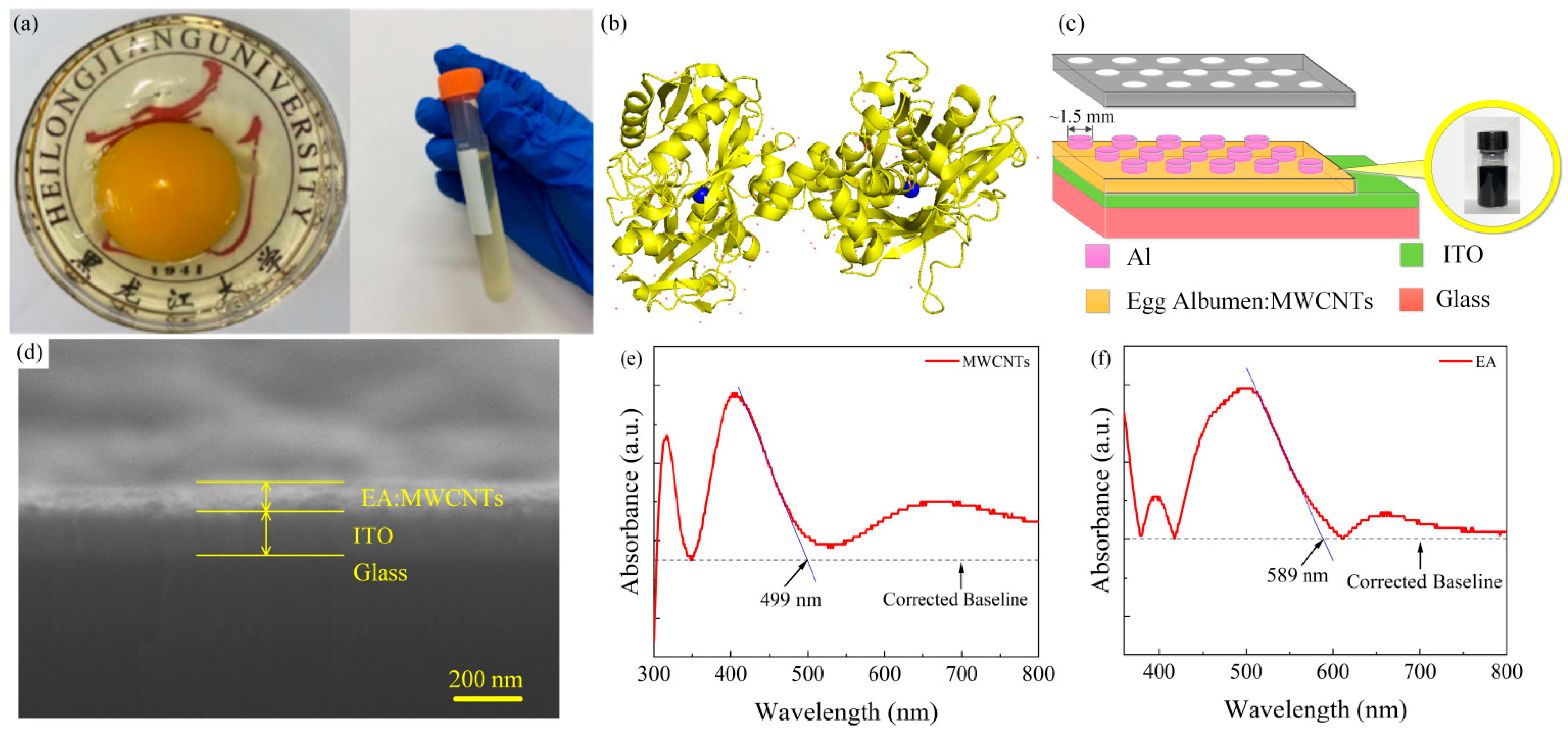

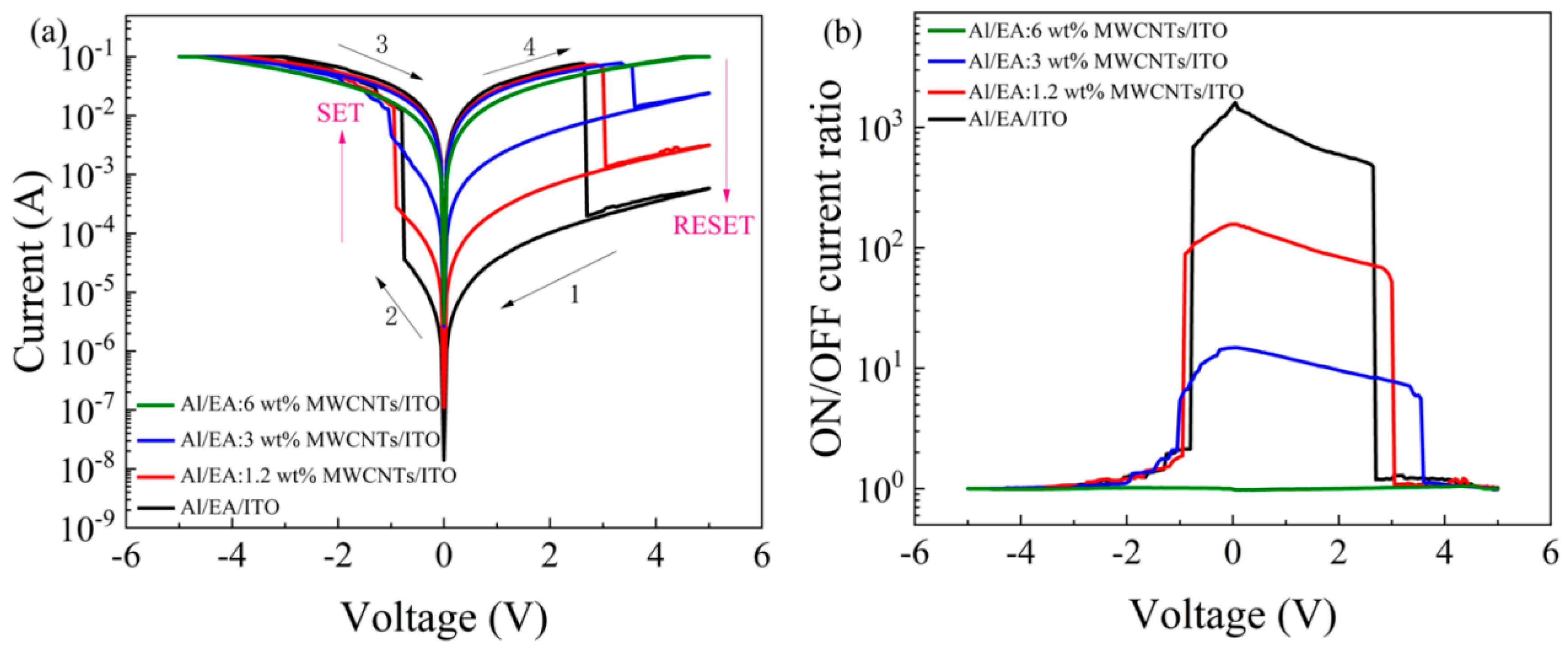
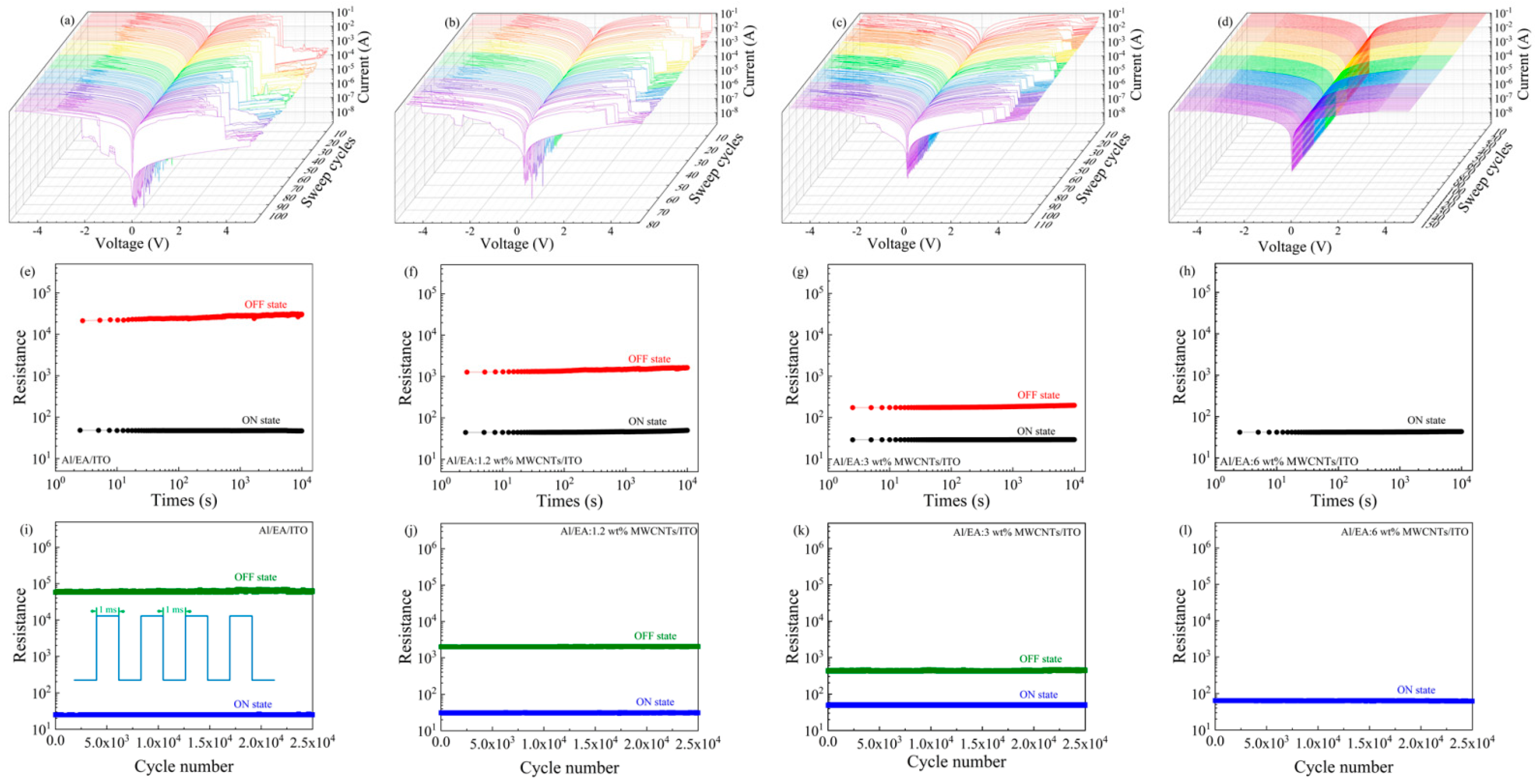
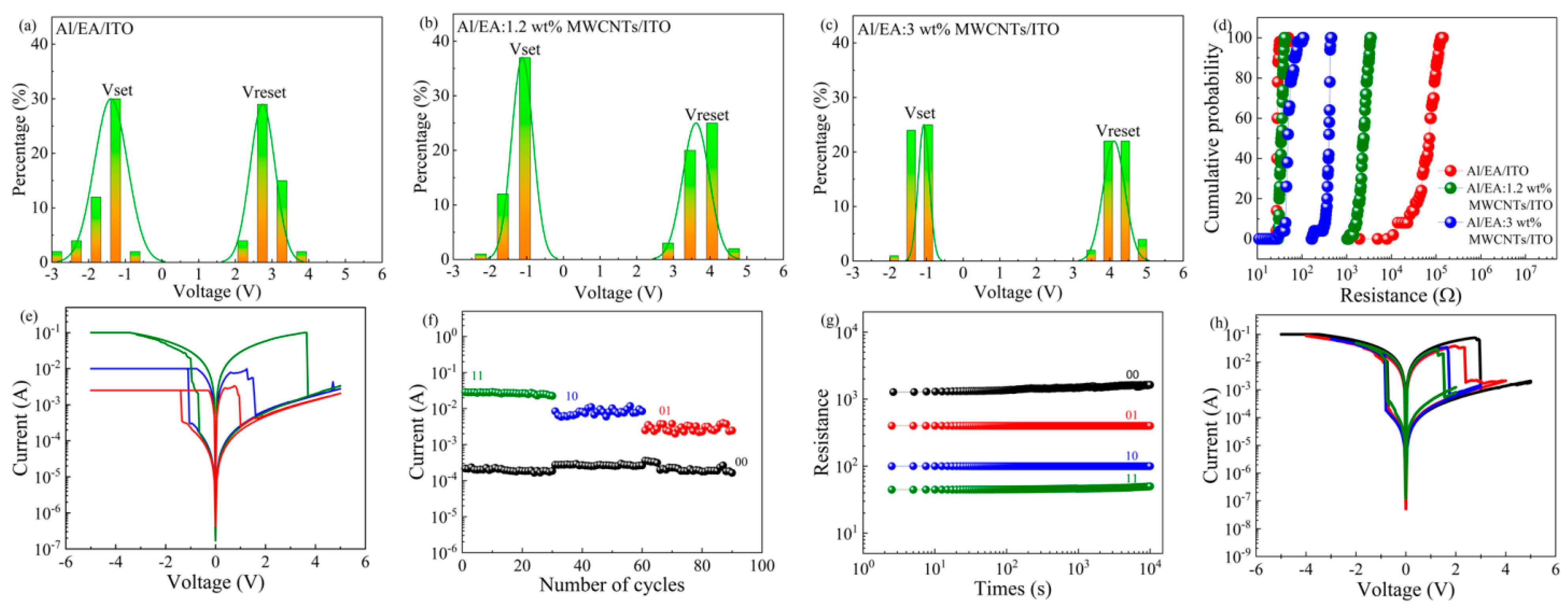
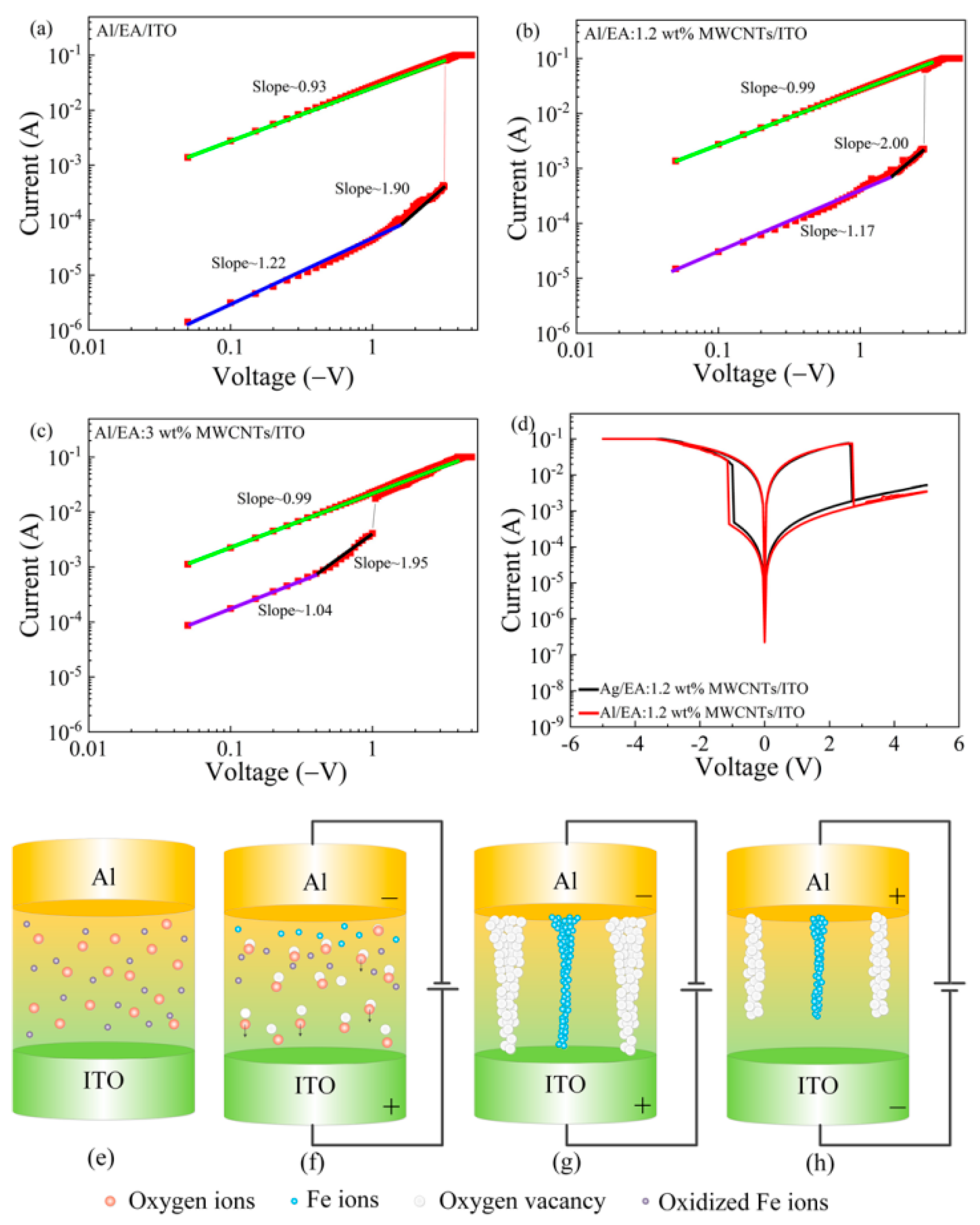
Publisher’s Note: MDPI stays neutral with regard to jurisdictional claims in published maps and institutional affiliations. |
© 2021 by the authors. Licensee MDPI, Basel, Switzerland. This article is an open access article distributed under the terms and conditions of the Creative Commons Attribution (CC BY) license (https://creativecommons.org/licenses/by/4.0/).
Share and Cite
Wang, L.; Yang, T.; Wen, D. Tunable Multilevel Data Storage Bioresistive Random Access Memory Device Based on Egg Albumen and Carbon Nanotubes. Nanomaterials 2021, 11, 2085. https://doi.org/10.3390/nano11082085
Wang L, Yang T, Wen D. Tunable Multilevel Data Storage Bioresistive Random Access Memory Device Based on Egg Albumen and Carbon Nanotubes. Nanomaterials. 2021; 11(8):2085. https://doi.org/10.3390/nano11082085
Chicago/Turabian StyleWang, Lu, Tianyu Yang, and Dianzhong Wen. 2021. "Tunable Multilevel Data Storage Bioresistive Random Access Memory Device Based on Egg Albumen and Carbon Nanotubes" Nanomaterials 11, no. 8: 2085. https://doi.org/10.3390/nano11082085
APA StyleWang, L., Yang, T., & Wen, D. (2021). Tunable Multilevel Data Storage Bioresistive Random Access Memory Device Based on Egg Albumen and Carbon Nanotubes. Nanomaterials, 11(8), 2085. https://doi.org/10.3390/nano11082085





